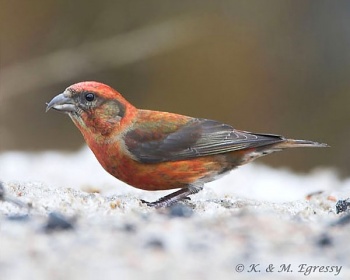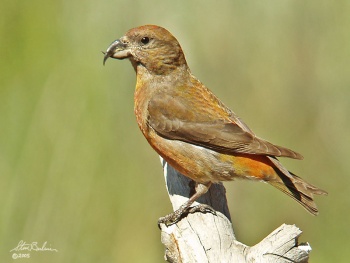Alternative name: Common Crossbill
- Loxia curvirostra
Identification
Length 14-20 cm (5½-7¾ in), weight 23-53 g
Male
- Medium-sized finch
- Red-orange body
- Brighter red on rump
- Dark brown wings
- Dark bill with crossed tip
- Notched tail
Female
- Yellow-orange crown and rump
- Olive-green body
- Grey-brown wings and tail
Juvenile
- Streaked greyer-brown overall
Similar species
Parrot Crossbill, and particularly Scottish Crossbill and Cassia Crossbill, are very similar; q.v.
Distribution
Throughout most of the Northern Hemisphere, almost wherever substantial conifer forests occur.
In the Old World, more-or-less continuous from Scotland east to the Pacific coast of Russia, with more isolated populations south to northwest Africa, the Mediterranean islands, Turkey, the Himalaya, southern Vietnam, and Taiwan.
In North America, from southern Alaska, Manitoba, Quebec, and Newfoundland, south in the west to northern Nicaragua, and in eastern United States to Wisconsin and North Carolina (in mountains). Small numbers winter irregularly south to the Gulf coast.
Taxonomy
Crossbill taxonomy is complex, and the validity of several of the taxa is disputed; several additional un-named taxa (particularly within L. c. curvirostra, where seven different call type groups have been noted in western Europe alone[1]) have also been suggested on the basis of differing call types. Scottish Crossbill probably also belongs as a subspecies here, though currently usually treated as a distinct species. At the other extreme, it has been suggested that all of the taxa could be considered as separate species.
Most of the taxa have strong associations with feeding on particular conifer species; the quip has been made - not without good justification - that "For North American crossbill ID, perhaps the best field guide is The Sibley Guide to Trees"[2]. However, all will readily shift to other conifer species in the event of a crop failure in their preferred species, though their feeding efficiency will be lower when doing so (which may prevent successful breeding while 'surviving' on the 'wrong' conifer).
The current subspecies listing (Clements[3] & IOC[4]) does not fully match call types, with many of the named subspecies being of uncertain application as they were described with no call information before the importance of calls was known[5]. There is a further mismatch in genetics, where only two groups are distinguishable, Old World (including Scottish Crossbill L. scotica and Parrot Crossbill L. pytyopsittacus!) and New World (including Cassia Crossbill L. sinesciuris)[6]. A treatment using genetic data would lead to a split into Common Crossbil L. curvirostra in the Old World, and Red Crossbill L. minor in the New World.
Cassia Crossbill L. sinesciuris[7] was formerly included in this species.
Subspecies
Twenty subspecies are recognised[3][4]; preferred food species noted where known:
Old World
- L. c. curvirostra - most of Europe and northern Asia; on Picea abies, Picea obovata and other Picea species
- L. c. corsicana - Corsica; on Pinus nigra
- L. c. balearica - Balearic Islands; on Pinus halepensis
- L. c. poliogyna - north-west Africa; on Pinus halepensis
- L. c. guillemardi - Turkey, Cyprus, Caucasus; on Pinus brutia
- L. c. mariae - Crimea; on Pinus nigra
- L. c. altaiensis - Altai and Sayan Mountains of central Asia; on Picea schrenkiana
- L. c. tianschanica - Tien Shan Mountains of central Asia; on Picea schrenkiana
- L. c. himalayensis - Himalayas; on Tsuga dumosa and Picea spp.
- L. c. meridionalis - southern Vietnam; on Pinus kesiya
- L. c. japonica - Japan; on Picea spp.
- L. c. luzoniensis - Luzon, Philippines; on Pinus kesiya
New World
- L. c. minor - south-central Canada, north-central USA; on Tsuga canadensis and Picea glauca
- L. c. sitkensis - coastal southern Alaska, south-western Canada, north-western USA; on Tsuga heterophylla
- L. c. bendirei (syn. L. c. neogaea) - south-western Canada, north-western USA; on Pseudotsuga menziesii
- L. c. pusilla - widespread in the United States and highly irruptive, occurring north to southern Canada and south to extreme northern Mexico
- L. c. benti - central Rocky Mountains, USA; on Pinus spp.
- L. c. grinnelli - south-western USA (California, Nevada); on Pinus spp.
- L. c. stricklandi - southeastern Arizona and southern New Mexico south through western Mexico (Sierra Nevada Occidental) to Chiapas; on Pinus spp.
- L. c. mesamericana - Central America (Guatemala, Nicaragua, Belize); on Pinus spp.
- L. c. percna - Newfoundland; on Picea mariana
Habitat
Coniferous forests, with a preference for spruce Picea in most areas, but pine Pinus in the case of several subspecies, particularly those to the south of the species' main range where spruces do not occur.
Behaviour
Diet
They primarily eat the seeds of conifers, extracted from the cones by twisting their bill tips between the scales; cones in the range 3-14 cm long are preferred. Other less important foods include insects and the buds and seeds of many shrubs and trees.
Vocalisation
References
- Robb, M. (2000). Introduction to vocalizations of crossbills in north-western Europe. Dutch Birding 22: 61-107.
- Post #200 et seq. in the Birdforum AOU 2017 Checklist proposals discussion thread
- Clements, J. F., T. S. Schulenberg, M. J. Iliff, S. M. Billerman, T. A. Fredericks, J. A. Gerbracht, D. Lepage, B. L. Sullivan, and C. L. Wood. 2021. The eBird/Clements checklist of Birds of the World: v2021. Downloaded from https://www.birds.cornell.edu/clementschecklist/download/
- Gill, F. and Donsker, D. (Eds). 2017. IOC World Bird Names (version 7.3). Available at http://www.worldbirdnames.org/.
- eBird: North American Red Crossbill Types: Status and Flight Call Identification
- Post #14 in the Birdforum Crossbill taxonomy discussion thread
- Benkman et al. (2009). A new species of the Red Crossbill (Fringillidae: Loxia) from Idaho. Condor 111 (1): 169–17.
Recommended Citation
- BirdForum Opus contributors. (2025) Red Crossbill. In: BirdForum, the forum for wild birds and birding. Retrieved 15 May 2025 from https://www.birdforum.net/opus/Red_Crossbill
External Links
GSearch checked for 2020 platform.1









